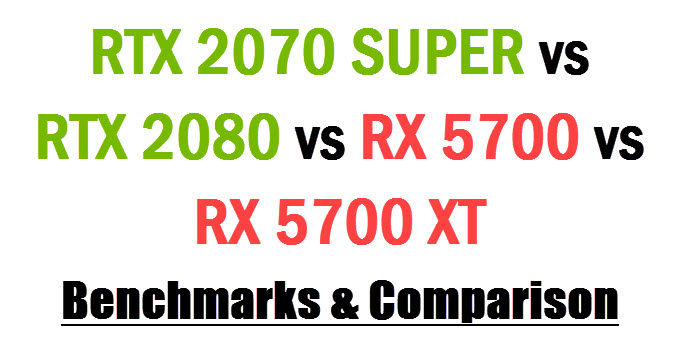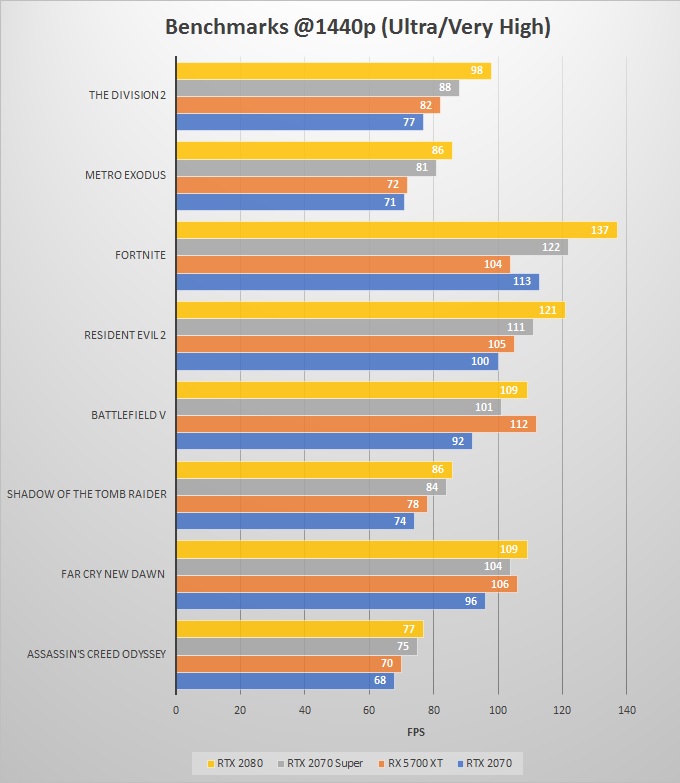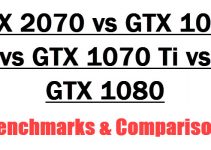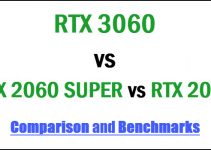If you are building a high-end gaming PC and looking for a good graphics card for 1440p or 4K gaming then some of the best options out there in the market are RTX 2070, RTX 2080, RTX 2070 Super, and RX 5700 XT. Here RTX 2070, RTX 2080 and RTX 2070 Super are the Nvidia RTX 20 series graphics card based on the Turing GPU architecture, while Radeon RX 5700 XT is a Navi GPU based Radeon RX 5000 series card from AMD. Choosing the right card can be a little tricky and confusing, because some of them have performance figures very close to each other, while others do offer great value for the price. So, if you are in a state of dilemma about which card to choose between them, then here I am going to compare all of them based on different parameters and factors that will make it easy for you to choose the right card for your specific needs.

RTX 2070 SUPER vs RTX 2080 vs RTX 2070 vs RX 5700XT
Here is the comparison between RTX 2070 SUPER, RTX 2080, RTX 2070, and RX 5700XT graphics cards based on their specifications, performance, pricing, power consumption, and features.
GPU Architecture
RTX 2070, RTX 2070 SUPER, and RTX 2080 belong to the Nvidia RTX 20 series lineup and are built on the Turing GPU architecture on the 12nm FinFET process. RTX 2070 SUPER and RTX 2080 share the same GPU core, which is TU104 while the RTX 2070 uses the TU106 core, which is also used in the RTX 2060 SUPER and RTX 2060. RTX 2080 comes with 2944 CUDA Cores, RTX 2070 SUPER has got 2560 and the RTX 2070 has 2304 CUDA Cores. On the other hand, RX 5700 XT is AMD 5000 series graphics card that uses the Navi GPU micro-architecture and replaces the old GCN architecture with RDNA. It is built on the smaller 7nm FinFET manufacturing process and uses the Navi 10 GPU chip. RX 5700 XT comes with 2560 Stream Processors.
| RTX 2070 | RTX 2070 SUPER | RTX 2080 | RX 5700 XT | |
| GPU Chip | TU106 | TU104 | TU104 | Navi 20 |
| GPU Architecture | Turing | Turing | Turing | Navi (RDNA) |
| Manufacturing Process | 12nm | 12nm | 12nm | 7nm |
| CUDA Cores / Stream Processors | 2304 CUDA Cores | 2560 CUDA Cores | 2944 CUDA Cores | 2560 SP |
Memory [VRAM]
All these graphics cards come with 8GB GDDR6 memory and have a 256-bit wide interface that runs at 14 Gbps. The memory bandwidth offered by these cards is 448 GB/s. So, in the video memory department, all these cards are on the same page.
| RTX 2070 | RTX 2070 SUPER | RTX 2080 | RX 5700 XT | |
| Memory Size | 8GB GDDR6 | 8GB GDDR6 | 8GB GDDR6 | 8GB GDDR6 |
| Memory Interface | 256-bit | 256-bit | 256-bit | 256-bit |
| Memory Speed | 14 Gbps | 14 Gbps | 14 Gbps | 14 Gbps |
| Memory Bandwidth | 448 GB/s | 448 GB/s | 448 GB/s | 448 GB/s |
Features
All the graphics cards here support DirectX 12, OpenGL 4.6, OpenCL, Vulkan, and FreeSync and are VR-ready. The features exclusive to RTX 20 series cards here is the support for Real Time Ray Tracing and DLSS (Deep Learning Super Sampling) using the RT Cores and Tensor Cores. Also, they come with USB Type-C port at the rear for VirtualLink for supporting next-generation VR headsets. Here, among all these cards, only RTX 2070 SUPER and RTX 2080 support multi-GPI configuration, which is through NVIDIA RTX NVLink Bridge (SLI). On the other hand, only the RX 5700 XT comes with the support for the new PCIe 4.0 standard or interface. When it comes to productivity, especially video editing & rendering, then all of them are capable of hardware-based encoding and decoding that helps to speed up the process.
Gaming Performance
Here are the benchmarks for these graphics cards in popular games at 1440p resolution.

Above, you can see that RTX 2080 is the fastest card, followed by RTX 2070 which is not too far behind. The performance of RTX 2070 Super is closely matched against the RTX 2080, which is a much expensive card. The Radeon RX 5700 XT offers great value for money and beats the higher-priced RTX 2070. Moreover, in some games, RX 5700 XT managed to beat the much higher-priced RTX 2070 Super, which shows its true potential.
Power Consumption
When it comes to power consumption, then RTX 2070 is the clear winner, while RTX 2070 SUPER and RTX 2080 come after it with a power consumption figure of 215W. The AMD card Radeon RX 5700 XT does consume a little more power compared to RTX 2070 SUPER and RTX 2080 at 225W. Except for RTX 2070, all these cards require 6-pin + 8-pin PCIe power consumption while there is only one 8-pin connector needed for RTX 2070. However, some overclocked RTX 2070 cards from various other graphics card manufacturers do need both 6-pin and 8-pin PCIe power connectors.
| RTX 2070 | RTX 2070 SUPER | RTX 2080 | RX 5700 XT | |
| PCI-E Connector | 8-pin | 6 pin + 8 pin | 6 pin + 8 pin | 6 pin + 8 pin |
| Power Consumption | 175W | 215W | 215W | 225W |
| Recommended PSU | 550W | 650W | 650W | 600W |
Pricing
The least expensive card here is Radeon RX 5700 XT, which sells at $399 MSRP, and the most expensive is the RTX 2080 with a price tag of $699. RTX 2070 and RTX 2070 SUPER are priced at $499 MSRP only. Here, the price mentioned is for Founders Edition / OEM graphics cards only, and you can check the current price of these cards from various graphics card manufacturers from the links given below.
| RTX 2070 | RTX 2070 SUPER | RTX 2080 | RX 5700 XT | |
| Price (MSRP) | $499 | $499 | $699 | $399 |
Check RTX 2070 Price on Amazon
Check RTX 2070 SUPER Price on Amazon
Check RTX 2080 Price on Amazon
Check RX 5700 XT Price on Amazon
RTX 2070 SUPER vs RX 5700XT vs RTX 2080 vs RTX 2070 Specifications
| RTX 2070 | RTX 2070 SUPER | RTX 2080 | RX 5700 XT | |
| GPU Chip | TU106 | TU104 | TU104 | Navi 20 |
| GPU Architecture | Turing | Turing | Turing | Navi (RDNA) |
| CUDA Cores / Stream Processors | 2304 CUDA Cores | 2560 CUDA Cores | 2944 CUDA Cores | 2560 SP |
| Memory Size | 8GB GDDR6 | 8GB GDDR6 | 8GB GDDR6 | 8GB GDDR6 |
| Memory Interface | 256-bit | 256-bit | 256-bit | 256-bit |
| Memory Bandwidth | 448 GB/s | 448 GB/s | 448 GB/s | 448 GB/s |
| Bus Interface | PCI Express 3.0 | PCI Express 3.0 | PCI Express 3.0 | PCI Express 4.0 |
| DirectX | 12 | 12 | 12 | 12 |
| OpenGL | 4.6 | 4.6 | 4.6 | 4.6 |
| Vulkan API | Yes | Yes | Yes | Yes |
| SLI / CrossFire | NA | SLI | SLI | NA |
| VR Ready | Yes | Yes | Yes | Yes |
| G-Sync / FreeSync | G-Sync | G-Sync | G-Sync | FreeSync |
| Power Consumption | 175W | 215W | 215W | 225W |
| Recommended PSU | 550W | 650W | 650W | 600W |
See also:
- RTX 2070 vs GTX 1070 vs GTX 1070 Ti vs GTX 1080 Comparison
- RTX 2080 SUPER vs RTX 2080 vs RTX 2080 Ti Comparison
- RTX 2060 SUPER vs RX 5700 vs RX 5700 XT vs RTX 2070 vs RTX 2060 Comparison
Final Verdict
If you want RTX 2080 like performance at a lower price then RTX 2070 Super is a great card to have. On the other hand, if you want the best bang for your bucks then you should definitely get the Radeon RX 5700 XT, which is a great card and beats RTX 2070 in almost every benchmark. Also, it beats RTX 2070 Super in some benchmarks and offers the best price-to-performance ratio. If you have any queries regarding them or still cannot decide on which card to choose from, then you can ask me your doubts in the comment section below.
(*This post may contain affiliate links, which means I may receive a small commission if you choose to purchase through the links I provide (at no extra cost to you). Thank you for supporting the work I put into this site!)


![Best RTX 4070 Cards for Max 1440p & High 4K Gaming [Custom Models] Best RTX 4070 Cards for Max 1440p & High 4K Gaming [Custom Models]](https://graphicscardhub.com/wp-content/uploads/2023/04/ASUS-TUF-Gaming-GeForce-RTX-4070-211x150.jpg)
Which is the best gpu among them for deep learning based computations?
I would say RTX 2080 but RTX 2070 SUPER offers better value for the money.
Hi, you have a great posting, thank you!
For content editing (I mostly use On1 and Affinity for photo and PowerDirector for video), do you still think the 5700 XT is the best bang for the buck? Would the base 5700 be adequate? I am pairing this with a Ryzen 3700X. I do not game much.
Will 16GB of ram be adequate, or should I go to 24 or 32 (the PC comes with 16, I would likey add another 16 later as it is less expensive)?
Lastly, do you have a recommendation for a relatively inexpensive X570 motherboard? I’m trying to keep the entire PC at less than $1500 but want it to be more or less future-proofed.
Thank you.
Hello Steve,
Thanks for the appreciation. I think Radeon RX 5700 should be more than enough for your requirements. For now, 16GB RAM is okay, but if your budget permits you then you can add another 8GB or even 16GB. For an affordable X570 motherboard, I would suggest Asus TUF GAMING X570-PLUS, which you can check at https://graphicscardhub.com/best-x570-motherboard/. Hope this helps and if you have any more doubts then feel free to ask.
Which is the best gpu among them for vr?
I would say RTX 2070 SUPER because it is fast as the RTX 2080 at much lower price.
Hi
Very informative, good job! I’m thinking of getting an Alienware R9. I have to purchase through a government approved vendor. Dell , Hp, Lenovo are my choices. Dell’s choices of GPUs include all of the ones you compare here. I am a Graphic Designer, I’ll be using this gaming tower for Maya, 3dMax, Adobe CC and other design/rendering apps. I will not be gaming on this unit. The CPU choices include 9th gen i7 9700 turbo or 9700K over clocked on all cores. There are other choices but I’m trying to keep my purchase below $1800 US. Which of these (if any) GPUs or set-up would you advise. Although I like the design/style of the unit, don’t be concerned about offering another option.
Jim
I would suggest Core i7 9700K with RTX 2070 SUPER.
Not sure if this is still active but I have a blower style gtx 1080, the gigabyte turbo one =S and was wondering if it would be worth getting the rx5700xt ? the card i currently have has the fan curve maxed out and still hits 79-80 degrees Celsius, Any help would be appreciated, I have found a 5700xt for 500aud and I know i can sell my 1080 locally for 450-500, thanks in advance.
Blower style cards do run hotter and noisier. I don’t think it is worth upgrading to a RX 5700 XT because it is only 10% to 15% faster (on average) than GTX 1080. Also, many users are facing a hell lot of trouble with AMD Radeon Drivers right now. You can try changing the thermal paste (I suggest Thermal Grizzly Kryonaut) and optimize the airflow inside the case to reduce the card’s temperature.